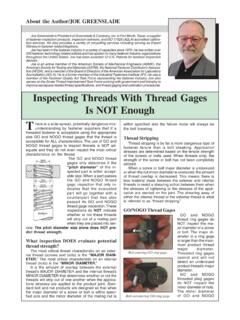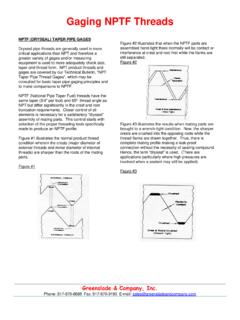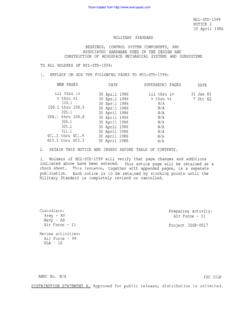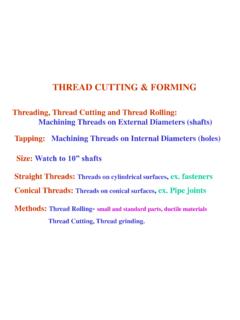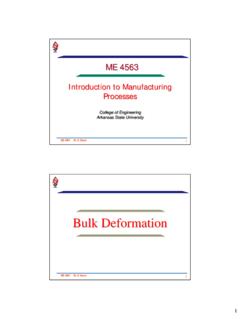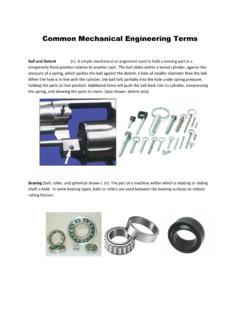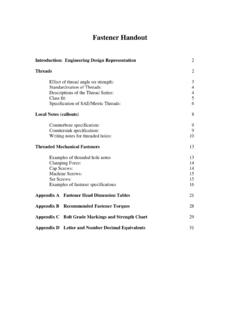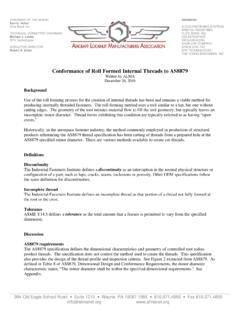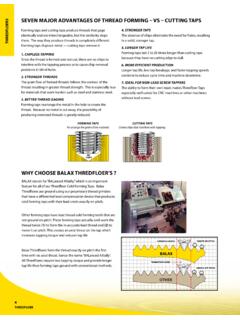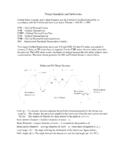Transcription of Are rolled internal threads as good as cut threads
1 are rolled internal threads as good as Cut threads ? Questions about internal rolled threads come up from time to time. Why do fastener manufacturers want to provide internal threads using the rolling rather than cutting process? Are rolled threads as strong as cut? How do you gage internal rolled threads verses internal cut threads . Why do screws tend to cross- thread in internal rolled threads more than internal cut threads ? These are good questions. Following are the answers: Q1. Why do fastener manufacturers want to provide internal threads using the rolling rather than cutting process? A1. rolling internal threads provide exactly the same benefits to the manufacturer that rolling external threads do. 1. rolling internal threads displaces material instead of creating scrap in the form of chips.
2 This can result in raw material savings. 2. rolling internal threads can be performed at a faster rate than cutting threads , thus yielding more parts per hour. Q2. Are rolled threads as strong as cut? A2. Yes, rolled threads are at least as strong as cut threads . 1. If the internally threaded fastener is not hardened by heat treatment the rolled thread is stronger than the cut thread because of the work hardening that occurs as a result of the process. This provides a part more resistant to thread stripping. 2. If the internally threaded product is hardened by heat treatment then the internal rolled threads and the cut threads have equal strength. Q3. How do you gage internal rolled threads verses internal cut threads : A3. The dimensional and inspection requirements for internal rolled threads are identical to those for cut threads .
3 internal threads must be inspected with threaded plug gages and cylindrical plug gages to evaluate the pitch diameter and minor diameter. The only difference is that internal rolled threads require a larger hole in the work pieces than do work pieces intended for cut threads . The reason is that when rolling internal threads , the pre-tap hole size in the work piece is approximately pitch diameter size. The material that is displaced by the crests of the tap s major diameter flows inward toward the center of the part to create the minor diameter. When creating an internal cut thread in a work piece, the pre-tap hole size is at the nut s minor diameter. The flute in the tap cuts the thread into the material instead of flowing the material to create the thread form. Q4. Why do screws tend to cross- thread in internal rolled threads more than internal cut threads ?
4 A4. When an internal thread is cut into a work piece the minor diameter of the internal thread is flat between each thread . When an internal thread is rolled , the material displaces in the work piece so the material is being pushed outward to conform to the major diameter of the tap. The material flows up the flanks on both the leading and trailing flanks of the tap to form the minor diameter of the internally threaded fastener. When the material approaches the interior of the fastener a small open valley is created at the root of the thread . The size of the valleys vary with the material being tapped and the pre-tap hole size in the work piece. Harder materials do not flow as readily as do softer materials. Using the same starting hole size the harder material is likely to leave a much larger valley than will the softer material.
5 When the valleys are too large they cause screws to cross thread because the external thread engages the valley on the minor diameter instead of engaging in the actual thread form. The size of these valleys is the result of how well the manufacturer selects the starting hole size based on the hardness of the material being tapped. Many people mistaken think that the starting hole size for all 5/16-24 rolled internal threads are the same regardless of the material being tapped. This is not true. To make good quality internal rolled threads the manufacturer needs to develop the ideal starting hole based on the material being tapped and the length of engagement. Done properly the valleys between threads can be maintained at a minimum size thus preventing screws from cross-threading. This same principle is involved when rolling external threads .
6 If the starting blank diameter size is too small large valleys will occur on the major diameter of the individual threads . There are many good reasons for considering the use of rolled threads in internally threaded fasteners. Many users balk at the idea of accepting rolled internal threads only because they are not familiar with them. When asked to consider the acceptance of a rolled thread also consider the points made above in determining if it can be applicable to your project. Representation of a roll formed internal thread . Cutting Tap verses Forming Tap
